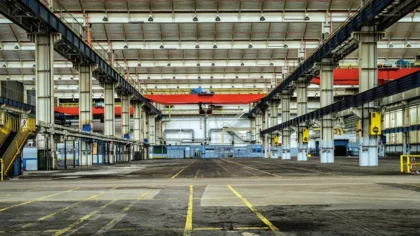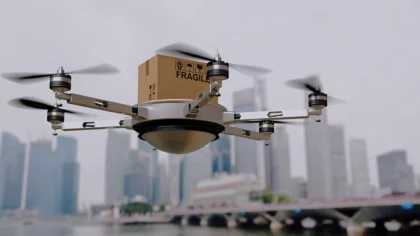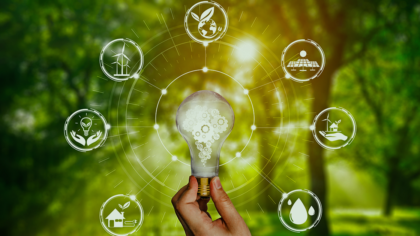Drones or unmanned aerial vehicles (UAVs) provide high-resolution images and unique perspectives to improve situational awareness. They find applications across industries from energy and entertainment to mining and emergency services. In this data-driven report, we give you innovation insights based on our analysis of 2450 drone startups & technologies so that you do not miss out on emerging solutions.
These drone applications allow businesses to find inefficiencies in their operations and improve maintenance planning. Read more to explore the impact of drones on 10 industries and how they advance your business.
Tree Map reveals the Impact of Drone Applications on 10 Industries
The Tree Map below illustrates the impact of drones on 10 industries in 2023 and 2024. The primary use case of drones across industries is inspection automation. Powered by advanced analytics or artificial intelligence (AI), drones automate route mapping and air navigation, reducing dependence on manual labor.
Drone-based inspections are used by the construction, manufacturing, energy, real estate, industry 4.0, and utility sectors. On the other hand, the agriculture industry leverages UAVs for crop monitoring and precision farming while they automate last-mile deliveries and material handling in logistics and healthcare operations. Drones also assist military and defense operations by offering real-time situational awareness and functioning as target decoys.
Global Startup Heat Map covers 2450 Drone Startups & Scaleups
The Global Startup Heat Map below highlights the global distribution of the 2 450 exemplary startups & scaleups that we analyzed for this research. Created through the StartUs Insights Discovery Platform, covering 3 790 000+ startups & scaleups globally, the Heat Map reveals that Western Europe has a high concentration of drone startups, followed by the US and India.
Below, you get to meet 10 out of these 2 450 promising startups & scaleups as well as the solutions they develop. These 10 startups are hand-picked based on criteria such as founding year, location, funding raised, and more. Depending on your specific needs, your top picks might look entirely different.
Impact of Drone Applications on 10 Industries
1. Construction
Drones replace the labor required for topographic mapping and land surveys. At the same time, they automate asset and construction progress tracking. This saves time and costs associated with these operations while improving visibility. Further, the construction sector uses drones for perimeter surveillance and to improve personnel safety through site monitoring.
Startups further leverage AI to analyze drone data to identify intruders and navigate workers around hazardous conditions. Construction firms utilize drones to inspect large-scale structures like bridges and towers, thus aiding in maintenance planning.
Huviair enables Remote Construction Management
Indian startup Huviair provides a drone-based visual intelligence platform for remote construction management. It combines drone data and cloud computing to visualize, analyze, and optimize various construction stages. Moreover, the platform offers stream flow simulations, volumetric analysis, and contour mapping. This enables construction companies to adhere to faster timelines and reduce reworking.
2. Agriculture
Growers use UAVs to monitor their crops, plant seeds, and more. Drone fertilization application is emerging as a top solution for labor-shortages. For instance, some startups develop drones that map farmlands and evaluate crops for diseases. Such solutions allow farmers to maximize yields, enable precision agriculture, and tackle labor shortages.
In livestock management, drones find applications in monitoring herds and pastures as well as preventing hustling. Recent advances in the drone sector aim to reduce the expenses associated with agricultural drones so that even small farmers are able to leverage them and improve food production.
Aero41 designs Agricultural Drones
Aero41 is a Swiss startup that provides autonomous drone solutions for crop protection. The startup’s machine control interface features a robust and light platform to plan and execute crop treatments quickly and efficiently. Aero41’s drones provide over 6 hours of autonomy and a maximum range of 10 km, relieving workers from spot inspections. The startup’s smart and ground-following UAVs also ensure targeted and spot application of chemicals to eliminate pests and maximize crop growth.
3. Manufacturing
Inefficiencies and non-compliances in production floors cause safety risks and lead to capital loss. That is why manufacturing plants use drones to track workers and assets to ensure safety compliance and improve worker safety. Additionally, drone-based monitoring provides insights into leaks or other anomalies, thus enhancing maintenance planning and worker safety.
UAVs monitor inventories in manual warehouses by leveraging sensors to read barcodes and radio-frequency identification (RFID) tags. Further, they automate material handling and enhance in-plant connectivity by streamlining intralogistics.
Flybotix provides Drone-assisted Indoor Inspections
Flybotix is a Swiss startup that provides a drone-assisted indoor inspection solution. The startup’s drone, ASIO, uses a patented propulsion system that extends flight time and reduces noise levels. Moreover, a lightweight protective cage surrounds the drone, helping it navigate through tight spaces using flight control algorithms. The startup also provides analysis software that continuously monitors for issues. This enables chemical plant operators to inspect boilers, tanks, and reactors without endangering workers, transitioning to preventive maintenance workflows.
4. Logistics
Since customers now prefer logistics providers offering same-day deliveries, they are integrating drones to automate last-mile operations. This enables businesses to mitigate delivery delays due to heavy traffic congestion and offer products at remote locations. In distribution centers, UAVs automate pallet scanning, inventory tracking, and material handling.
Moreover, drones allow logistics companies to reduce dependence on manual labor while reducing operational costs. Using UAVs to handle packages also reduces the carbon footprint of logistics operations and enables seamless reverse logistics, improving customer satisfaction.
Gather enables Autonomous Warehouses
Gather is a US-based startup that uses a fleet of drones with cameras to map a warehouse environment. The drones autonomously scan the environment, collect stock data, measure temperature, and read barcodes. Gather thus offers inventory-as-a-service and fully automates warehouses without in-house product development.
5. Energy
The energy industry comprises capital-intensive infrastructures like solar farms and turbines. Drones utilize high-resolution imaging to capture detailed data on asset conditions to aid decision-making for maintenance operations. They also allow energy companies to leverage site-specific information like solar irradiance to improve energy project development.
Further, asset monitoring using UAVs mitigates time-intensive manual inspections while reducing costs. Moreover, drone-assisted inspections enhance worker safety by removing labor from hazardous environments like wind turbine blades.
Union Robotics aids Energy Infrastructure Inspection
US-based startup Union Robotics manufactures drones for the energy industry. The startup’s Meadowhawk range of UAV products features cameras and sensors for thermal high-resolution imagery and hotspot identification. These drones operate in high-voltage environments and collect data on hard-to-reach components for energy infrastructure inspection.

6. Real Estate
Real estate companies utilize drones to monitor properties to facilitate maintenance operations. High-resolution drone images provide highly accurate site maps, offering a better perspective for potential buyers and improving property appraisals. Unlike other industries, real estate companies leverage drones for marketing as well.
The dynamic, aerial visuals from drones allow them to offer a new outlet to market properties and listings, converting more prospects. Some startups also stitch together imagery from UAVs to provide an immersive view of property listings.
DroneAce aids Geospatial Land Mapping
DroneAce is an Australian startup that leverages drones to better understand land features for real estate development. The startup’s drones hover over the concerned property and record multiple images from different angles. It then combines and processes the images to create 3D orthomosaic models highlighting particular areas’ unique features. This information allows property developers to improve real estate planning and buyer engagement.
7. Military Technology
Military drones primarily find applications in reconnaissance missions to collect data on enemy activities and terrains. This avoids exposure of military personnel to life-threatening situations and improves mission success rates. They also function as target decoys to mislead opponents and launch attacks from various directions. In combat missions, drones deliver mission-critical resources like ammo and emergency medicines as well as target opponents and enemy weapons.
Aurea Avionics provides Drone-based Surveillance
Aurea Avionics is a Spanish startup that enables drone-based surveillance for the military and defense industry. The startup’s intelligence, surveillance, and reconnaissance drone, Seeker UAS, is deployable in rugged terrain as it needs minimal infrastructure to land or take off.
The drone also features electro-optical/infrared (EO/IR) sensors to capture real-time images in daylight and lowlight scenarios. Armed forces use Seeker UAS to track high-risk targets and gather crucial military intelligence.
8. Industry 4.0
UAVs play a vital role in automating various aspects of industrial operations. This includes maintenance planning, asset monitoring, and progress tracking. For example, oil and gas plants primarily use drones to inspect pipelines for leakages, whereas production floors use them to automate material handling and worker monitoring.
They also integrate with industrial control systems to streamline operations. Moreover, drones remove workers from hazardous industrial environments, improving their safety.
Engineers with Drones facilitates Industrial Inspections
Irish startup Engineers with Drones aids industrial inspections. The startup utilizes UAVs to inspect sites and machinery in pharma, manufacturing, food production, and refinery facilities. For instance, drones provide a faster and more efficient means to perform routine and ad hoc inspections. It reduces the risks associated with manual operations and eliminates the possibility of human errors while minimizing production downtimes.
9. Healthcare
The healthcare sector leverages medical drones to deliver medical devices and supplies on demand. UAVs allow pharma companies and hospitals to avoid direct contact with patients and speed up medicine and treatment kit delivery. At the same time, drones enable quick transport of diagnostic testing kits between labs and patients by mitigating road traffic.
Further, medical drones allow pharma companies and hospitals to deliver vaccines and medicines in remote areas and overcome terrain challenges. For older patients, UAVs provide essential items, such as medicines and lab reports, and periodically inspect them for safety purposes.
Skyfarer builds Medical Drones
UK-based startup Skyfarer makes drones for the healthcare industry to deliver medical payloads. The startup provides fast and direct transportation of blood, pharmaceuticals, vaccinations, and aseptic equipment. Its drones thus mitigate inefficiencies due to traffic congestions and address transportation discontinuities in medical delivery.
10. Utilities
Manually inspecting massive utility infrastructures is highly capital- and time-intensive. Besides, conventional efforts put workers in hazardous conditions, high-voltage power lines, for example. Drones eliminate this by streamlining inspection activities and, thereby enhancing maintenance planning.
They also allow utilities to transition from reactive to proactive maintenance, furthering infrastructure life. Water management companies also use drones to gather real-time hydrological data and enable better flood management. At the same time, waste management organizations leverage UAVs to collect garbage, monitor waste treatment, and track emissions, among others.
My Drone Services enables Remote Utility Asset Maintenance
US-based startup My Drone Services offers remote utility asset maintenance with drones. The startup’s drones leverage corona and high-resolution cameras to provide a detailed picture of telecom tower and power line conditions. They also utilize radiometric thermal cameras to measure the temperature of every single pixel on the screen, providing precise measurements. Additionally, the startup inspects structural integrity and corrosion as well as detects leaks in gas pipelines.
Discover All Drone Applications & Technologies
While drones primarily find applications in last-mile deliveries and industrial inspections, advances in AI, remote sensing, and materials will widen their use cases. For example, solar-powered drones are able to operate continuously to improve surveillance operations. Such innovations, along with cost-efficient drone designs and vertical take-off and landing (VTOL) technologies, will improve their integration across industries. Get in touch to identify specific drone startups & solutions that advance your business!



![AI Implementation | A Comprehensive Strategic Guide for Enterprises [2025-2030]](https://www.startus-insights.com/wp-content/uploads/2025/04/AI-Implementation-SharedImg-StartUs-Insights-noresize-420x236.webp)






